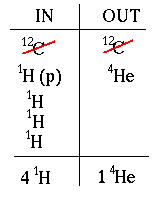-
In all stars found on the MAIN SEQUENCE, hydrogen is currently
being fused to form Helium. This is their source of energy against
gravitational collapse. As we learned already, stars like the Sun use the
Proton-Proton Chain to fuse hydrogen. A very small
amount of energy is also created through what is called:
The CNO (Carbon-Nitrogen-Oxygen) Cycle
 Starting at the top left and moving clockwise:
Starting at the top left and moving clockwise:
1) 12C, Carbon with 6 protons and 6 neutrons, collides and sticks with Hydrogen, p. A gamma ray is also released. This creates Nitrogen (13N).
2) 13N decays (a proton changes to a neutron and releases the beta+ particles) to an isotope of Carbon, 13C.
3) Another proton is added to 13C), creating Nitrogen again, but a more massive isotope, 14N.
4) Yet another proton is added and 14N becomes 15O.
5) 15O decays (proton --> neutron, releasing beta+ particles) to create 15N.
6) Finally, another Hydrogen (p) is added to 15N,
but now it's too big! An alpha particle (the Nucleus
of a Helium Atom) is released and we are back to our 12C

Let's count up what went in and what came out. We started with 12C, and ended with 12C. All we did was keep adding Hydrogen atoms until a Helium atom broke off!
Just like the P-P Chain, four Hydrogen atoms (the same as bare protons) are converted to one Helium atom. The energy difference (E=mc2) creates the thermal pressure inside the star.
For very massive stars, with very hot central cores, the CNO Cycle is the predominant way in which they fuse Hydrogen to Helium.